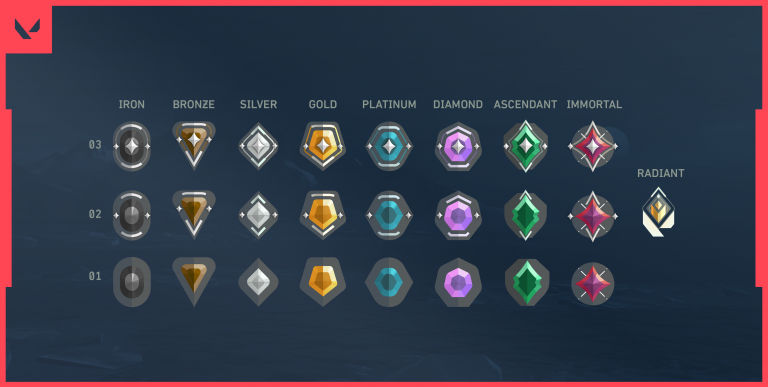The ranking system in Valorant plays a crucial role in the game’s experience. For those eager to challenge their abilities in a competitive environment, participating in ranked matches is essential. This article will cover all the details you need to understand about Valorant’s ranks and more.
Contents
All Valorant Ranks in Order
Valorant’s ranking system is designed to cater to players of all skill levels, from beginners to elite competitors. There are nine main ranks in the game, each further divided into three sub-ranks, except for the highest rank. Here is the complete order of ranks in Valorant:
- Iron
- Iron 1
- Iron 2
- Iron 3
- Bronze
- Bronze 1
- Bronze 2
- Bronze 3
- Silver
- Silver 1
- Silver 2
- Silver 3
- Gold
- Gold 1
- Gold 2
- Gold 3
- Platinum
- Platinum 1
- Platinum 2
- Platinum 3
- Diamond
- Diamond 1
- Diamond 2
- Diamond 3
- Ascendant (introduced to create a smoother progression between Diamond and Immortal)
- Ascendant 1
- Ascendant 2
- Ascendant 3
- Immortal
- Immortal 1
- Immortal 2
- Immortal 3
- Radiant
- Radiant (highest rank, without sub-divisions)
Each rank reflects a different level of skill, with players progressively moving up as they improve their performance in competitive matches.
Valorant Act Rank
The Act Rank is a unique feature in Valorant that tracks a player’s performance over a competitive season, known as an “Act.” Each Act lasts approximately two months. During this period, players aim to win competitive matches to achieve their highest rank possible.
- Top Act Rank: This is the highest rank a player achieves during an Act.
- Act Rank Badge: Displays the nine best-ranked wins of the player for the Act, forming a triangle shape on their profile.
- Act Rank Borders: As players win more matches, they fill up sections of a badge, which reflects their progress and skill level throughout the Act.
At the end of each Act, players’ Act Ranks are locked in their profiles, showcasing their peak performance for that period. This system encourages players to push for better ranks while also providing a sense of accomplishment.
Valorant Rank Distribution 2024
Understanding the rank distribution helps players gauge where they stand in the competitive landscape. As of 2024, the distribution of players across various ranks is as follows:
- Iron: 8%
- Bronze: 17%
- Silver: 21%
- Gold: 18%
- Platinum: 16%
- Diamond: 12%
- Ascendant: 5%
- Immortal: 2%
- Radiant: 0.1%
These statistics highlight that the majority of players fall within the Silver to Gold range, indicating a balanced competitive field. Only a small percentage reach the upper echelons of Immortal and Radiant, reserved for the elite players of the game.
Valorant Rank Placements and Restrictions
When starting their journey in Valorant’s competitive mode, players must first complete five placement matches. These initial matches determine their starting rank based on performance.
Key Aspects of Placement Matches:
- Performance-Based: Initial matches weigh heavily on personal performance and match outcomes.
- Rank Decay: Players who have been inactive may find their rank decayed, ensuring that active and improving players are fairly ranked.
Restrictions in Competitive Play:
- Group Restrictions: Players can queue with others of similar ranks. However, strict limitations exist to prevent large rank disparities within a team.
- Rank Adjustments: After each match, a player’s rank can go up, down, or remain the same, depending on the match outcome and individual performance.
These placements and restrictions are designed to maintain fair and competitive matches, ensuring players are matched with and against others of similar skill levels.
Conclusion
Valorant’s ranking system is a well-structured mechanism that provides players with clear goals and a sense of progression. From the initial placements to the pinnacle of Radiant, each step in the ranking ladder represents a player’s growth and skill. Understanding this system helps players not only set realistic goals but also appreciate their journey through the competitive ranks of Valorant.
For those striving to climb the ranks, focus on consistent performance, strategic gameplay, and teamwork. These elements are key to advancing through Valorant’s competitive landscape.


